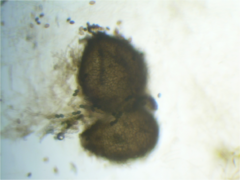Sordariomycetes
| Sordariomycetes | |
|---|---|

| |
| Sordaria fimicola perithecium magnified 40x | |
| Scientific classification | |
| Kingdom: | |
| Division: | |
| Subdivision: | |
| Class: | Sordariomycetes
|
| Subclasses & Orders | |
Incertae sedis | |
Sordariomycetes is a class of fungi in the subdivision Pezizomycotina (Ascomycota), consisting of 28 orders, 90 families, 1344 genera,.[1]
Sordariomycetes generally produce their asci in perithecial fruiting bodies.
Sordariomycetes are also known as Pyrenomycetes, from the Greek πυρἠν - 'the stone of a fruit' - because of the usually somewhat tough texture of their tissue.[2]
Sordariomycetes possess great variability in morphology, growth form, and habitat. Except for having perithecial (flask-shaped) fruiting bodies, ascomata can be less frequently cleistothecial (like in the genera Anixiella, Apodus, Boothiella, Thielavia, Zopfiella),[3][4] fruiting bodies may be solitary or gregarious, superficial, or immersed within stromata or tissues of the substrates and can be light to bright or black. Members of this group can grow in soil, dung, leaf litter, and decaying wood as decomposers, as well as being fungal parasites, and insect, human, and plant pathogens.[5][6][7]
Genera incertae sedis
These 108 genera within the Sordariomycetes have an uncertain taxonomic placement (incertae sedis), according to the 2007 Outline of Ascomycota. A question mark preceding the genus name means the placement of that genus within this order is uncertain.[8]
Abyssomyces – Acerbiella – Acrospermoides – Ameromassaria – Amphisphaerellula – Amphisphaerina – Amphorulopsis – Amylis – Anthostomaria – Anthostomellina – Apharia – Apodothina – Apogaeumannomyces – Aquadulciospora – Aquamarina – Aropsiclus – Ascorhiza – Ascoyunnania – Assoa – Aulospora – Azbukinia – Bactrosphaeria – Barrina – Biporispora – Bombardiastrum – Brenesiella – Byrsomyces – Byssotheciella – Caleutypa – Calosphaeriopsis – Caproniella – Chaetoamphisphaeria – Ciliofusospora – Clypeoceriospora – Clypeosphaerulina – Cryptoascus – Cryptomycina – Cryptovalsa – Cucurbitopsis – Curvatispora – Dasysphaeria – Delpinoëlla – Diacrochordon – Dontuzia – Dryosphaera – Endoxylina – Esfandiariomyces – Frondisphaera – Glabrotheca – Heliastrum – Hyaloderma – Hydronectria – Hypotrachynicola – Immersisphaeria – Iraniella – Khuskia – Konenia – Kravtzevia – Kurssanovia – Lecythium – Leptosacca – Leptosphaerella – Leptosporina – Lyonella – Mangrovispora – Melomastia – Microcyclephaeria – Mirannulata – Monosporascus – Myrmecridium – ?Naumovela – ?Neocryptospora – Neolamya – Neothyridaria – Oceanitis – Ophiomassaria – Ornatispora – Pareutypella – Phomatospora – Phyllocelis – Plectosphaerella – Pleocryptospora – Pleosphaeria – Pontogeneia – Porodiscus – Protocucurbitaria – Pulvinaria – Pumilus – Rehmiomycella – Rhamphosphaeria – Rhizophila – Rimaconus – Rhopographella – Rhynchosphaeria – Rivulicola – Romellina – Saccardoëlla – Sarcopyrenia – Sartorya – Scharifia – Scoliocarpon – Scotiosphaeria – Servaziella – Sporoctomorpha – Stearophora – Stegophorella – Stellosetifera – Stomatogenella – Strickeria – Sungaiicola – Synsphaeria – Tamsiniella – Thelidiella – Thyridella – Thyrotheca – Trichospermella – Trichosphaeropsis – Vleugelia – Zignoina
Familia incertae sedis
These are families in the Sordariomycetes whose taxonomic affinities are not sufficiently well known to be placed in any order.
- Annulatascaceae
- Apiosporaceae
- Batistiaceae
- Glomerellaceae
- Jobiellaceae
- Kathistaceae
- Magnaporthaceae
- Obryzaceae
- Papulosaceae
- Plectosphaerellaceae
- Thyridiaceae
- Vialaeaceae
References
- ^ Maharachchikumbura, S. S., Hyde, K. D., Jones, E. G., McKenzie, E. H., Huang, S. K., Abdel-Wahab, M. A., ... & Hongsanan, S.. (2015). "Towards a natural classification and backbone tree for Sordariomycetes. " Fungal Diversity. p. 72.1.
{{cite book}}: CS1 maint: multiple names: authors list (link) - ^ Century Dictionary entry for pyrenomycetes
- ^ Lundqvist N. 1972. Nordic Sordariaceae s. lat. Symbolae Botanicae Upsalienses 20: 1-374.
- ^ von Arx J.A. (1975). On Thielavia and some similar genera of ascomycetes. Studies in Mycology 8: 1-31.
- ^ Spatafora JW. (1995). Ascomal evolution of filamentous ascomycetes: evidence from molecular. Canadian Journal of Botany S73: 811-815.
- ^ Neuveglise C, Brygoo Y, Vercambre B, Riba G. (1994). Comparative-analysis of molecular and biological characteristics of strains of Beauveria brongniartii isolated from insects. Mycological Research 98: 322-328.
- ^ Berbee ML, Taylor JW. (1992). Two ascomycete classes based on fruiting-body characters and ribosomal DNA sequence. Molecular Biology of Evolution 9: 278-284.
- ^ Lumbsch TH, Huhndorf SM. (December 2007). "Outline of Ascomycota – 2007". Myconet. 13. Chicago, USA: The Field Museum, Department of Botany: 1–58.
Further reading
- Barr M. E. 1987. Prodromus to Class Loculoascomycetes. Newell, Amherst, Mass.
- Barr M. E. 1990. Prodromus to nonlichenized, pyrenomycetous members of Class Hymenoascomycetes. Mycotaxon 39: 43-184.
- Castlebury, L. A., Rossman, A. Y., Jaklitsch, W. J., Vasilyeva, L. N. 2002. A preliminary overview of the Diaporthales based on large subunit nuclear ribosomal DNA sequences. Mycologia 94: 1017-1031.
- Lumbsch H. T. 2000. Phylogeny of filamentous ascomycetes. Naturwissenchaften 87: 335-342.
- Luttrell E. S. 1951. Taxonomy of the Pyrenomycetes. University Missouri Stud. Sci. Ser. 24: 1-120.
- Lutzoni F., Kauff F., Cox C. J., McLaughlin D., Celio G., Dentinger B., Padamsee M., Hibbett D., James T. Y., Baloch E., Grube M., Reeb V., Hofstetter V., Schoch C., Arnold A. E., Miadlikowska J., Spatafora J., Johnson D., Hambleton S., Crockett M., Shoemaker R., Sung G.-H., Lücking R., Lumbsch T., O'Donnell K., Binder M., Diederich P., Ertz D., Gueidan C., Hall B., Hansen K., Harris R. C., Hosaka K., Lim Y.-W., Liu Y., Matheny B., Nishida H., Pfister D., Rogers J., Rossman A., Schmitt I., Sipman H., Stone J., Sugiyama J., Yahr R. and Vilgalys R. 2004. Assembling the fungal tree of life: progress, classification, and evolution of subcellular traits. Am. J. Bot. 91: 1446-1480.
- Spatafora J. W. and Blackwell M. 1993. Molecular systematics of unitunicate perithecial ascomycetes: the Clavicipitales-Hypocreales connection. Mycologia 85: 912-922.
